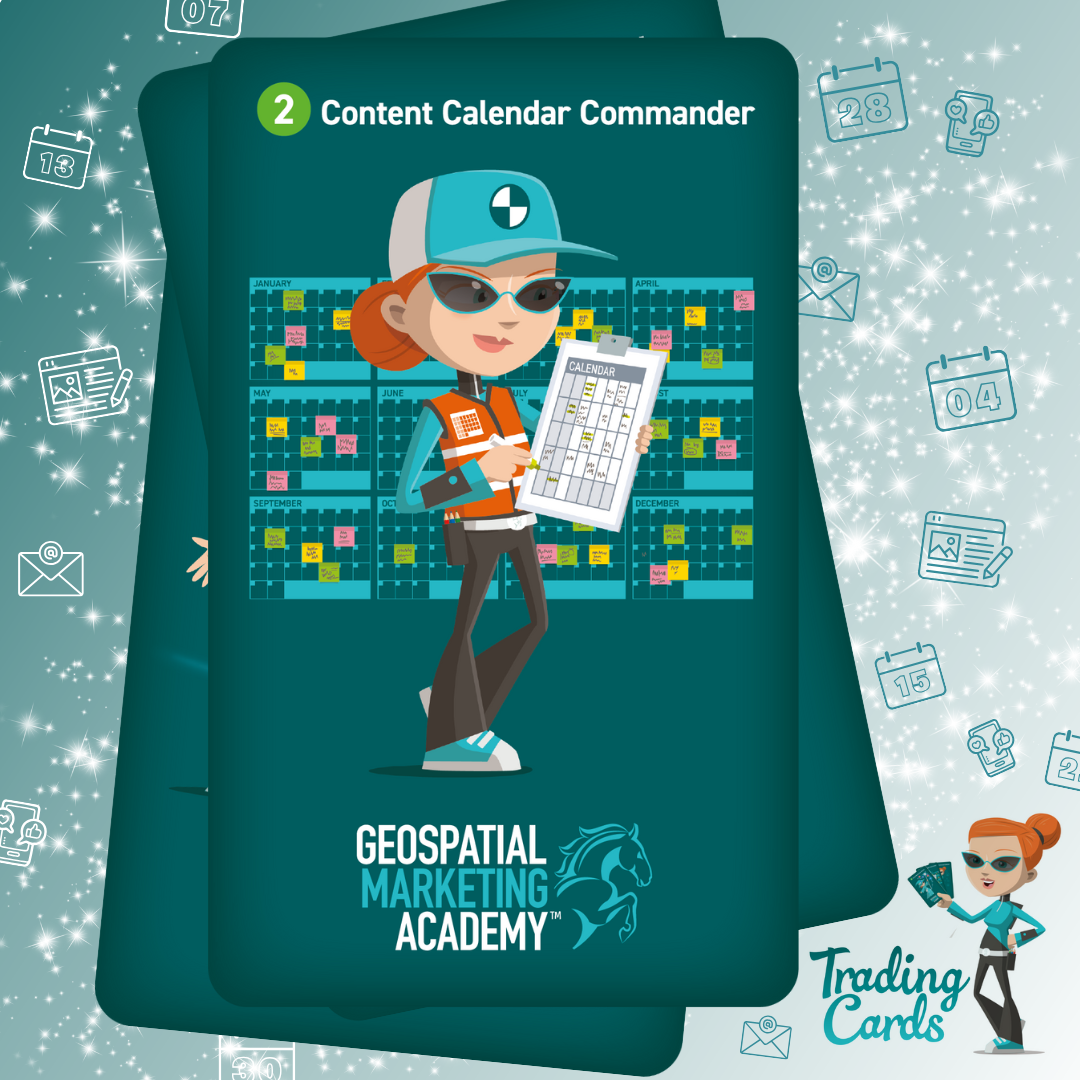The second in a series of blogs based on our awesome Geospatial Marketing Trading Cards.
How Geospatialers Can Take Control of Their Marketing (and Their Sanity!)

Are you a surveyor who scrambles to post on social media at the last minute, goes months (or even years) without sharing a new blog post, or has a neglected list of newsletter subscribers receiving nothing but tumbleweeds?
You’re not alone. Heaps of geospatial professionals are stuck in a cycle of mad panicking when it comes to creating content, with no real plan or strategy. They’re unsure who they’re talking to, wasting precious time on inefficient, ad-hoc processes.
The result? Inconsistent messaging, missed opportunities and a whole lot of unnecessary stress.
Thankfully, there’s a better way. Enter – The Content Calendar. 🙌
Why Content Calendars Work Wonders
1. Planning and consistency are the secret weapons of successful geospatial marketing
A well-organised content calendar keeps you on track, helps manage your workflow, and ensures your audience hears from you regularly across multiple touchpoints with content that matters to them. With free tools like Trello or Airtable, you can build a month-long content plan without spending a penny on expensive software.
2. When you plan ahead, pressure and overwhelm melt away
No more last-minute panic posting just for the sake of it. Your content quality will soar because you’ve given yourself enough time to structure and polish it. Even better, you can map out a full month of content in just a few hours, giving you more time to focus on your business.
3. A solid plan helps you get more mileage from your content
For example, an email newsletter can be repurposed into a LinkedIn newsletter, a blog post, and several social media posts. A focused social media campaign can be transformed into a blog post or an email series. Save time, reach more people and boost your marketing impact. A no brainer right?
But What About Spontaneity?
You’ll still want to post ad-hoc content – and you still should. Reacting to breaking news, sharing updates from events, reposting mentions from customers/businesses/industry experts, or jumping on the latest trends. The best strategy is a combination of both: a pre-planned calendar for consistency (and all the other reasons above 👆), mixed in with spontaneous, on-the-ground posts. Best of both worlds!
How to Create Your Content Calendar
Step 1. Define Your Goals
Before you start planning, decide what you want to achieve. Typical goals for geospatial businesses include:
- Increasing brand awareness
- Showcasing expertise
- Driving website traffic
- Engaging with industry peers
- Generating leads and sales
Step 2: Set Up Your Calendar with Free Tools
We recommend Trello or Airtable (no, we’re not paid to say that – we just love them!).
- Trello: Use its visual, card-based system to track content progress. Create lists like Ideas, Drafting, Editing, Scheduled, and Published. Add cards for each content piece, with due dates and checklists.
- Airtable: Set up a table with columns for Content Title, Type (Social Post, Blog, Email), Platform, Status, Copy, Link to Doc, Publish Date, and Assigned Team Member. Each row is a content plan.
Ooorrr, if you’re an Academy member, you get access to our ready-made Airtable planner.
Step 3: Plan Content Themes
Keep your content balanced by dividing it into themes. You might use a different theme each week or mix them up daily. For example:
- Educational (tips, trends)
- Behind-the-scenes (team, tools)
- Case studies and testimonials
- Engagement (polls, Q&A)
Plot key dates like exhibitions or holidays into your calendar. This helps you create timely, relevant content and avoid wasting your best ideas during quiet periods.
Step 4: Fill Your Calendar
Add your best ideas to the planner. Some people like to block out a few hours and plan the whole month in one go; others prefer to do a week or a theme at a time. Find what works for you.
Elaine, for example, likes to focus and get it all done in one creative burst. But if inspiration doesn’t strike, she knows it just takes one good idea to get back on track!
Want some inspo? Take a look at our blog with 19 social media post ideas for Geospatial businesses and tons of tips.
Step 5: Schedule Your Content
Most social platforms and WordPress have built-in schedulers. Free tools like Meta Business Suite (for Facebook & Instagram) or LinkedIn’s post scheduler can help you post across multiple platforms. Paid tools like Hootsuite or Sprout Social offer extra analytics if you need them, but they’re not essential for everyone.
Scheduling in advance keeps your content consistent, even during busy times. Let automation do the heavy lifting.
Step 6: Track Your Results
Monitor which posts and content types perform best and use those insights to refine your strategy. This helps you grow your audience and improve your marketing over time.
Over to You!
You now have everything you need to move from Panic Poster to Content Calendar Commander. Here’s a quick recap:
- Planning saves time and reduces stress
- Consistency builds your brand and audience
- Repurpose content to get more value from your efforts
- Mix planned and spontaneous posts for maximum impact
- Use free tools to organise, schedule, and track your content
Or, if you’d rather make things even easier…
Let Us Do the Hard Work
The Geospatial Marketing Academy includes plug-and-play content calendars and blueprints for success. Join our online course and learning community, and let us help you grow your geospatial business – guaranteed.
See what’s included and start your journey to stress-free, effective marketing today.
Elaine Ball Ltd: Raising the standard of geospatial marketing, one surveyor at a time.
